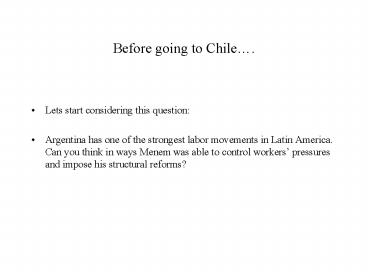Before going to Chile. - PowerPoint PPT Presentation
1 / 12
Title:
Before going to Chile.
Description:
Chile illustrates a ... Third, Chile shows an important anomaly in relation to other ... Economically, Chile has enjoyed more stability than other ... – PowerPoint PPT presentation
Number of Views:117
Avg rating:3.0/5.0
Title: Before going to Chile.
1
Before going to Chile.
- Lets start considering this question
- Argentina has one of the strongest labor
movements in Latin America. Can you think in ways
Menem was able to control workers pressures and
impose his structural reforms?
2
Dont get lost!Where we are in this class
- Again (and again), our main questions are
- Why have Latin America not achieved greater
economic development? - What makes Latin America politically instable?
- Argentina illustrates one path of economic and
political development - Tensions and conflicts within the elite and the
exclusion of important sectors have seriously
damaged options of economic development and
political stability. - Chile illustrates a different path
- First, progressive inclusion of social sectors
allowed an extensive period of political
stability (until 1973!) - Second, while polarization was a crucial factor
explaining the military coup in 1973, political
consensus was a crucial factor explaining the
re-establishment of democracy in 1990. - Third, Chile shows an important anomaly in
relation to other democratic regimes the high
level of military autonomy
3
Chile The Big Picture
- Brief Political Chronology
- Republican Period (1810-1925)
- 1810-1831 Conservative Republic (oligarchic
governments) - 1831-1891 Liberal Republic (Still oligarchic
governments) - 1891-1925 Parliamentary Republic (Oligarchic
govts. Inclusion middle-c) - 1925-1932 Instability period. (Short military
coup in 1931) - Progressive democratization (1925-1973)
- 1932-1952 Popular Front period (4 middle class
govts/) - 1958-1964 Alessandris govt. Conservative party
govt. - 1964-1970 Freis govt. Center-Christian Democrat
- 1970-1973 Allendes govt. Leftist-Socialist
- Military regime
- 1973-1990 Pinochets military Regime.
Dictatorship - Re-establishment of Democracy
- 1990-1994 Aylwin govt. Center-Left coalition
(Concertacion) - 1994-2000 Freis govt. Center-Left coalition
(Concertacion) - 2000-2006 Lagos govt. Center-Left coalition
(Concertacion)
4
Chile The Big Picture
- In comparison to other Latin American countries,
Chile has had a very stable and progressively
inclusive political system. - Economically, Chile has enjoyed more stability
than other countries in Latin America in the last
20 years. - Two central questions to analyze
- A) What are the factors causing this long
stability? - B) Why was this stability violently broken in
1973?
5
Chile today some facts
- Chile Long and thin country (3,000 x 90
kilometers) - 15 millions people/ Favorite sports Soccer and
Tennis - Economy
- Until 1970s, based on a single commodity
copper. - After 1970s Wine, grapes, fruits, fish, wood
- After 1983 consistent economic growth.
Unilateral openness to trade - Social Clear social stratification
upper/middle/lower classes - Culture Chile is culturally conservative.
Influence of Church and upper-cl. - Politics and Institutions
- Strong party system (Clear ideological divisions
bet. Right/Center/left - Low levels of corruption within the elite
- Strong state
- Main problems
- The role of the military in politics
- High levels of income inequality
6
Explaining Chiles Political Stabilitybetween
1810-1973
- The main characteristics of the economy in Chile
between 1810 and 1973 - 1800s-early 1900s Agriculture and mining
(Silver, nitrates, copper) - 1900-1973 Copper, some industrialization during
1940s (textiles) - 1970s-2000 Copper, sea products, agricultural
products - Who was controlling the economy during the
1800s? - When the middle class enter into the political
scene in Chile? - When did workers enter into the political scene
in Chile?
7
ChileExplaining Political Stability
- As Argentina, Chie was controlled by powerful
groups of society (the elite). But, landowners
and mining owners agreed to resolve disputes
within the political system. - In Chile, when new groups of society pressured
the elites, these elites responded by repressing
them first, but including them later. - The example of Alessandri during 1920s approving
the Labor Code. - Key aspect government preemption of conflicts
8
ChileExplaining political Stability
- Thus, political stability can be explained
because - A) governments preempted conflicts by including
new sectors, anticipating conflicts. - b) Political parties represented peoples
demands - The Era of Party Politics (1932-1973)
- What are the main features of the era of party
politics? (121)
9
ChileFrom Stability to Instability
- Competition, Coalitions, democratic politics.
- Thus, Chile a case of extreme political stability
until 1973. - Why a military coup?
- Different interpretations
- external factors (role of the US)
- Domestic factors
- Role of the Military
- Role of political parties
- Today we will analyze only the political party
factor
10
ChileFrom Stability to Instability
- To explain the military coup, we need to
understand what was going on in Chile before. - Freis economic and social policies (1964-1970)
- Eduardo Frei, a Christian Democrat, moderate
president, very charismatic . - The slogan of his government Revolution in
Liberty - Economic and social policies? (123-126)
- Did the US and World Bank support his policies?
11
ChileFrom Stability to Instability
- Salvador Allende (1970-1973) The Chilean way
toward Socialism - Doctor, Socialist, supported by workers and a
marxist-coalition - 1970 elections
- Socialist (Allende) 36.2
- Conservative (Alessandri) 34.9
- Center (Tomic) 27.8
- The Electoral system problem (winner-take-all, no
second round) - Economic and social policies?
- Did the US and the World Bank support this
government?
12
ChileThe unexpected outcome
- Before 1960s competition, coalitions, democratic
politics - During 1970s competition, polarization,
anti-democratic politics - September 11, 1973
- The military coup was against Chiles Republican
traditions - The military coup was driven by a strong
anti-marxist sentiment - Instability explained by
- A) unwillingness to negotiate and achieve
agreements - B) Extreme polarization among parties
- C) Willingness of military institutions to
eliminate a sector of society - D) Acceptance of international actors of this
violent path.































